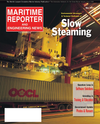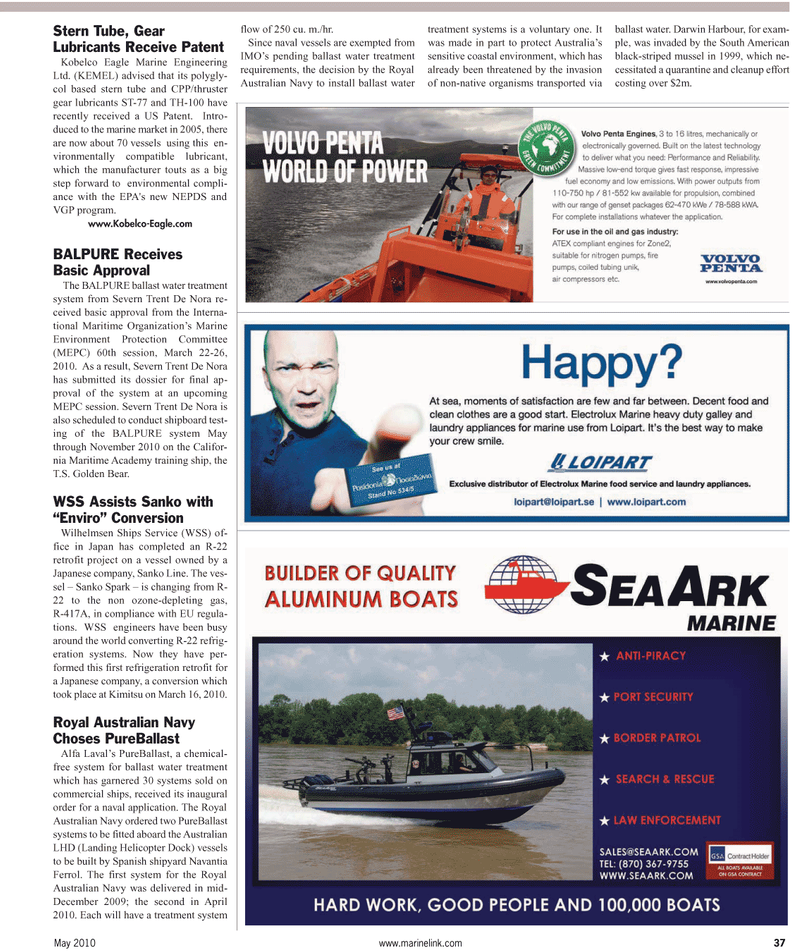
Page 37: of Maritime Reporter Magazine (May 2, 2010)
Read this page in Pdf, Flash or Html5 edition of May 2, 2010 Maritime Reporter Magazine
Stern Tube, Gear
Lubricants Receive Patent
Kobelco Eagle Marine Engineering
Ltd. (KEMEL) advised that its polygly- col based stern tube and CPP/thruster gear lubricants ST-77 and TH-100 have recently received a US Patent. Intro- duced to the marine market in 2005, there are now about 70 vessels using this en- vironmentally compatible lubricant, which the manufacturer touts as a big step forward to environmental compli- ance with the EPA's new NEPDS and
VGP program. www.Kobelco-Eagle.com
BALPURE Receives
Basic Approval
The BALPURE ballast water treatment system from Severn Trent De Nora re- ceived basic approval from the Interna- tional Maritime Organization’s Marine
Environment Protection Committee (MEPC) 60th session, March 22-26, 2010. As a result, Severn Trent De Nora has submitted its dossier for final ap- proval of the system at an upcoming
MEPC session. Severn Trent De Nora is also scheduled to conduct shipboard test- ing of the BALPURE system May through November 2010 on the Califor- nia Maritime Academy training ship, the
T.S. Golden Bear.
WSS Assists Sanko with “Enviro” Conversion
Wilhelmsen Ships Service (WSS) of- fice in Japan has completed an R-22 retrofit project on a vessel owned by a
Japanese company, Sanko Line. The ves- sel – Sanko Spark – is changing from R- 22 to the non ozone-depleting gas,
R-417A, in compliance with EU regula- tions. WSS engineers have been busy around the world converting R-22 refrig- eration systems. Now they have per- formed this first refrigeration retrofit for a Japanese company, a conversion which took place at Kimitsu on March 16, 2010.
Royal Australian Navy
Choses PureBallast
Alfa Laval’s PureBallast, a chemical- free system for ballast water treatment which has garnered 30 systems sold on commercial ships, received its inaugural order for a naval application. The Royal
Australian Navy ordered two PureBallast systems to be fitted aboard the Australian
LHD (Landing Helicopter Dock) vessels to be built by Spanish shipyard Navantia
Ferrol. The first system for the Royal
Australian Navy was delivered in mid-
December 2009; the second in April 2010. Each will have a treatment system flow of 250 cu. m./hr.
Since naval vessels are exempted from
IMO’s pending ballast water treatment requirements, the decision by the Royal
Australian Navy to install ballast water treatment systems is a voluntary one. It was made in part to protect Australia’s sensitive coastal environment, which has already been threatened by the invasion of non-native organisms transported via ballast water. Darwin Harbour, for exam- ple, was invaded by the South American black-striped mussel in 1999, which ne- cessitated a quarantine and cleanup effort costing over $2m.
May 2010 www.marinelink.com 37

 36
36

 38
38
